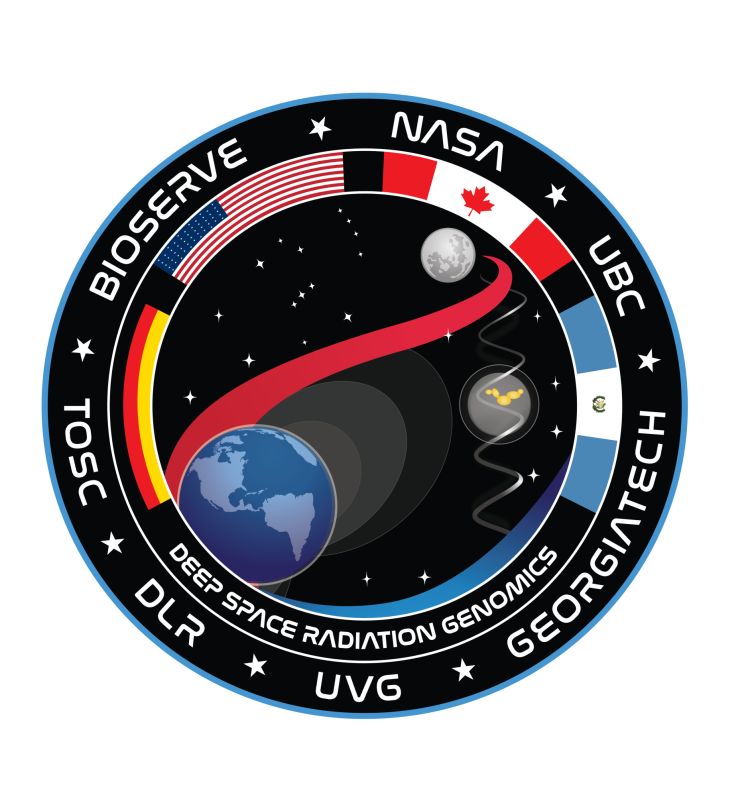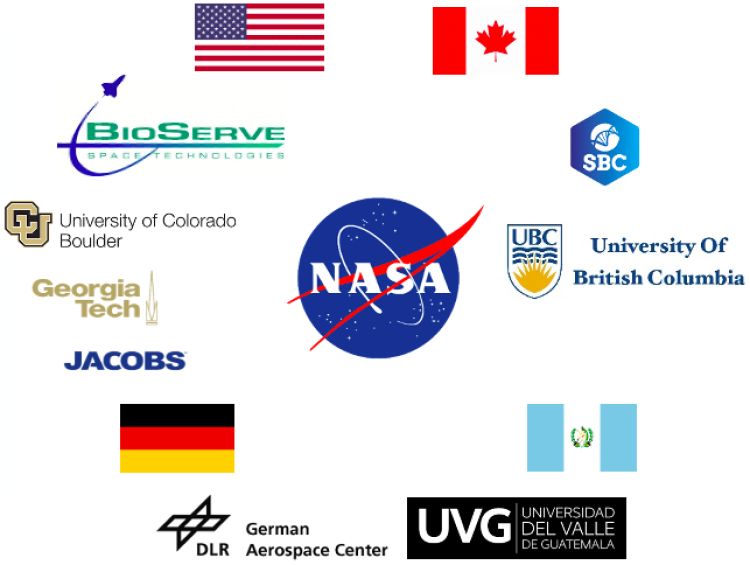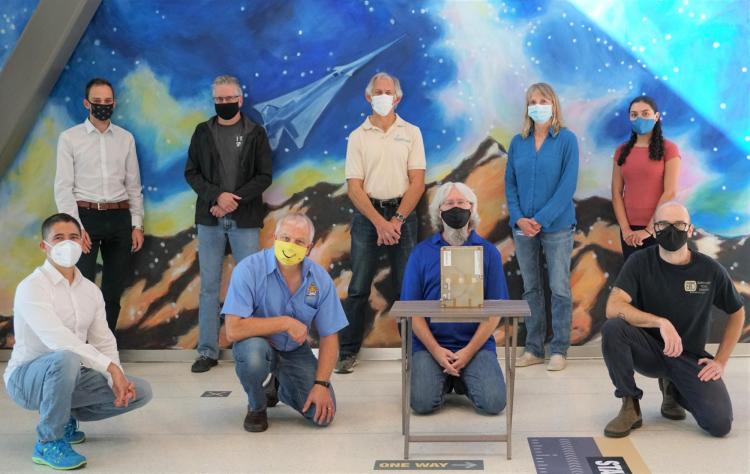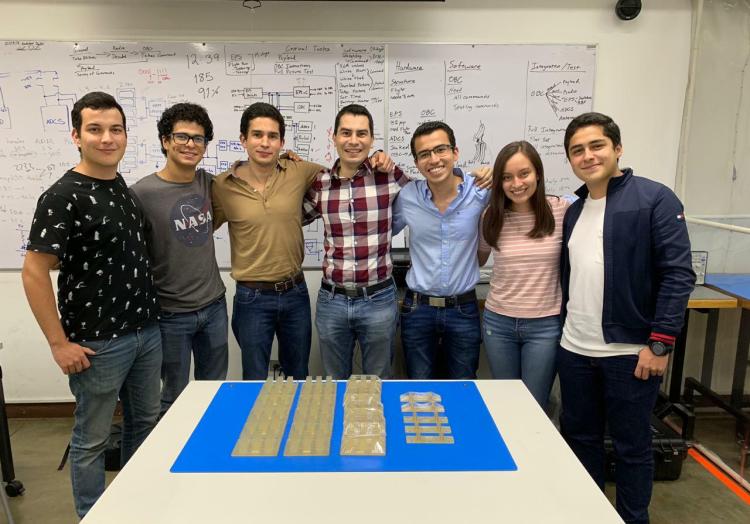Deep Space Radiation Genomics (DSRG) (Artemis I)
Funding agency
NASA (80NSSC19K0708)
Dates
Project start: May, 2019
Expected launch around the Moon (NASA's Artemis I mission): 2022
Expected launch to ISS: 2022

Patch design credit: Pamela Flores, Marta Cortesao, and Bonnie Fukazawa.
Humans will once again venture to the Moon and eventually, beyond. While the region of space where the International Space Station orbits is partially protected from space radiation by our planet’s magnetosphere, astronauts going to the Moon will be exposed to higher doses of galactic cosmic rays and solar radiation. Because neither humans, or for that matter, any terrestrial life forms have experienced long-term exposure these environments, we don’t yet fully understand how such radiation affects biological systems. For example, it is crucial to be able to address:
- What level and kind of damage can we expect to cells and their DNA as a result of these types of radiation?
- What are the biological processes that improve cells’ ability to thrive under conditions of microgravity and space radiation?
- Which DNA repair mechanisms are most effective under these conditions?
What are this project's objectives?
The overarching aim of this project is to identify the metabolic and genomic pathways affected by microgravity, space radiation, and a combination thereof. These observations will then be used to inform pathway-specific and gene-specific approaches designed to ameliorate the detrimental effects of long-term radiation exposure.
How is this being done?
Because it is prohibitive to study most organisms with a sufficiently large sample size and for a sufficient number of generations, especially for humans, model organisms can be used as powerful proxies to understand such fundamental gene × environment questions. By selecting a model organism that shares many of the key, evolutionarily conserved aspects being studied, one can use large populations of model organisms, with well characterized genomes, to refine human tests which can be addressed with small, focused studies. In this case, we will use yeast, because 70% of its essential genes have a human homolog (i.e. they are also found on the human genetic code), and over half of these homologs can functionally replace their human counterpart. More specifically, this project will use a molecularly barcoded yeast genome-wide knockdown collection, a set of systematically engineered strains each deleted for a single gene) that will enable the systematic interrogation of the effect of microgravity, space radiation, and a combination thereof in each gene.
To differentiate the effects of microgravity and space radiation on each strain, an experimental set of all mutants will be flown beyond the van Allen belts on Orion’s Artemis I Mission (considered in microgravity and irradiated by space radiation) and equivalent sets will be cultured asynchronously on board the International Space Station (ISS) (considered in microgravity but mostly – although not completely – protected of space radiation by the van Allen Belts), and on Earth. The experiment will have a controlled-start once the spacecraft has past Earth’s magnetosphere on its way to the Moon, and will be conducted in the Peristaltic Laboratory for Automated Science with Multigenerations (PLASM) spaceflight hardware.
The Team
Our team is composed of scientists, engineers, and undergraduate and graduate students from two national space agencies (NASA, German Aerospace Center (DLR)), four universities (University of British Columbia, University of Colorado, Boulder, the Georgia Institute of Technology (Georgia Tech), and Universidad del Valle de Guatemala (UVG)), two research centers (Sequencing and Bioinformatics Consortium and BioServe Space Technologies), and an implementation partner (Jacobs). The team is located in four countries around the globe: United States, Canada, Germany, and Guatemala.

Principal Investigator: Luis Zea, Ph.D.
Co-Principal Investigator: Corey Nislow, Ph.D.
Co-Investigator: Louis Stodieck, Ph.D.
Collaborators: Ralf Möller, Ph.D., Christopher Carr, Ph.D., and Tobias Niederwieser, Ph.D.
PLASM Development Team: Tobias Niederwieser, Ph.D., Alex Hoehn, Ph.D., Jim Wright, Mike Grusin, Ian Peck, Gary Stanish, Pamela Flores, Sam Piper, Louis Stodieck, Ph.D., Stefanie Countryman, Maggie Kolicko, and Luis Zea, Ph.D.
Modeling of Moon's position with respect to Earth's magnetotail: Valerie Bernstein, Kaiya Wahl, and Prof. Delores Knipp.
Irradiation Campaigns: Felix Fuchs, Marta Cortesao, and Ralf Moeller
Yeast Collections: Samantha Breaux, Hamid Gaikani, Mina Khoshnoodi, and Prof. Corey Nislow
Implementation: Kamber Scott, Ariana Lutsic, and Erica Bumgardner

PLASM development team at BioServe Space Technologies (University of Colorado Boulder). From left to right: Luis Zea, Ph.D., Tobias Niederwieser, Ph.D., Mike Grusin, Alex Hoehn, Ph.D., Louis Stodieck, Ph.D., Jim Wright, Stefanie Countryman, Pamela Flores, and Ian Peck.
Students
University of Colorado Boulder
- Sam Piper
- Pamela Flores graduated with a B.S. in Biochemistry and Microbiology from Universidad del Valle de Guatemala and is currently pursuing a PhD. in Molecular, Cellular and Developmental Biology at CU. Pamela's PhD thesis focuses on space microbiology. Pamela has experience in molecular cloning, confocal microscopy, RNA sequencing, transcriptomic analysis, among other skills. She helped testing and monitoring yeast growth in PLASM.
- Kerry Wahl (supervised by Prof. Delores Knipp)
- Valerie Bernstein (supervised by Prof. Delores Knipp)
University of British Columbia
UBC students are supervised and guided by Prof. Corey Nislow.
- Samantha Breaux - Sam received her BSc in Microbiology at the University of Washington in 2017. Since starting her graduate program at UBC in 2018, Sam has been involved in a wide array of genomic projects, including; nanopore sequence to track Cystic Fibrosis bacterial outbreaks, training Pharmacists to interpret pharmacogenomic data and designing environmental selections and high-throughput screening to improve yeast ethanol and fuel production. Sam is involved in all aspects of the wet lab components of the yeast project.
- Hamid Gaikani
- Mina Khoshnoodi
DLR
DLR students are supervised and guided by Prof. Dr. Ralf Moeller.
- Katharina Siems
- Felix Fuchs
- Marta Cortesão
UVG
UVG students are supervised and guided by Profs. Rodrigo Aragón and Andres Viau.
- Diego Aguirre
- Diego Hernandez
- Eileen Meda
- Esteban Herbruger
- Iñaki Alvarado

Left to right: Esteban Herbruger, Iñaki Alvarado, Prof. Aragón, Prof. Viau, Diego Aguirre, Eileen Meda, and Diego Hernandez
Produced Project Bibliography
Books
Pathak, Y., Araújo dos Santos, M., Zea, L. Handbook of Space Pharmaceuticals. Springer International Publishing
Peer-Reviewed Journal Papers
- Zea, L., Piper, S. S., Gaikani, H., Khoshnoodi, M., Niederwieser, T., Hoehn, A., ... & Nislow, C. (2022). Experiment verification test of the Artemis I ‘Deep Space Radiation Genomics’ experiment. Acta Astronautica, 198, 702-706.https://doi.org/10.1016/j.actaastro.2022.06.018
Conference Papers and Posters, Open-Access Code, Podcasts, and STEM outreach
- Zea, L., Levine, H., Santamaria, S., Hammond, T., Brandizzi, F., Henessa, T., Artemis I Biological Payloads Panel, ASGSR 2023
- Zea, L., Nislow, C., Artemis I’s Deep Space Radiation Genomics Opportunities, Constraints, & Challenge Solving, NASA Artificial Intelligence / Machine Learning (AI/ML) Working Group, April 10, 2023
Zea, L., Niederwieser, T., Hoehn, A., Grusin, M., Wright, J., Stanish, G., Piper, S., Flores, P., Griffith, R., Gaikani, H., Khoshnoodi, M., Siems, K., Cortesao, M., Wahl, K,. Bernstein, V., Knipp, D., Wilson, K., Scott, K., Lutsic, A., Soler, M., Sato, K., Viau, A., Aragon, R., Stodieck. L., Countryman, S., Carr, C.E., Moeller, R., Nislow, C., From Idea to Lunar Orbit Flight Readiness - Implementation of the Artemis I 'Deep Space Radiation Genomics' (DSRG) Yeast Experiment, American Society for Gravitational and Space Research (ASGSR) Conference, November 3-7, 2021
- Zea, L., Piper, S., Gaikani, H., Khoshnoodi, M., Niederwieser, T., Hoehn, A,. Grusin, M., Wright, J., Flores, P., Wilson, K., Lutsic, A., Stodieck, L., Carr, C.E., Moeller, R., Nislow, C., Experiment Verification Test of the Artemis I 'Deep Space Radiation Genomics' Experiment, IAC-21-A.2.7x65012, 72th International Astronautical Congress, Dubai, United Arab Emirates
- Zea, L., Nislow, C., First Controlled Biological Experiments beyond the Van Allen Belts, American Institute of Aeronautics and Astronautics (AIAA) Rocky Mountain Chapter Annual Technical Symposium, University of Colorado Boulder, September 29, 2021
- Bernstein, V. and Wahl, K. (2021). Identifying and Visualizing the Moon's Position with respect to the Earth's Magnetotail (v1.0.0). Zenodo. [Github]
- Wahl, K.R., Bernstein, V., Knipp, D., and Zea, L., Maximizing Space Radiation Exposure for the Deep Space Radiation Genomics (DSRG) Experiment on Artemis 1, 18th Space Weather Conference in the American Meteorological Society 101st Meeting 10-14 January 2021 (Virtual)
- Fiske Planetarium Podcast “A View From Earth”, Episode 8 - Life finds a Way - Or does it? Guests: Luis Zea & Bruce Jakosky, July 2020 [Podcast] [Video]
- Wahl, K., Bernstein, V., Knipp, D. Deep Space Radiation Genomics (DSRG) Experiment on Artemis 1: Magnetotail and Bow shock Affect, Research Experience for Undergraduates (REU) Final Presentations, University of Colorado, Boulder, July 29, 2020
- Meda, E., Herbruger, E., Hernandez, D., Aragón, R., Aguirre, D., Alvarado, I., Zea, L., Viau, A., Piezas para proyecto DSRG - Artemis 1, UVG 2020 Science Fair
- Knipp, D., Wahl, K., Bernstein, V., Zea, L. Sending Tiny Life Forms to Space. ED032 - The Up-Goer Five Challenge: Explaining big important things in simple words. AGU 2020 Fall Meeting, December 1-7, 2020
- Breaux S, Fuchs F, Cortesao M, Siems K, Stodieck L, Niederwieser T, Zea L, Carr CE, Moeller R, Nislow C. "Irradiation Ground Control for a Genome-Wide Yeast Fitness Profiling Experiment On Board Orion’s Artemis 1 Mission." 35th Annual Meeting of the American Society for Gravitational and Space Research, Denver, CO, November 20-23, 2019.
- Zea L, Niederwieser T, Stodieck L, Carr C, Moeller R, Nislow C. "Experiment Design for a Genome-Wide Yeast Fitness Profiling Experiment On Board Orion’s Artemis 1 Mission." 70th International Astronautical Congress (IAC), Washington, DC, October 21-25, 2019.
- Zea, L., Niederwieser, T., Stodieck, L,. Carr, C., Moeller, R., Nislow, C., Experiment Design for a Genome-Wide Yeast Fitness Profiling Experiment On Board Orion’s Artemis 1 Mission, IAC-19-A2.7.9x51501, 70thInternational Astronautical Congress (IAC) 2019, Washington, D.C.
Further reading on the yeast collections
- Hamza A, Tammpere E, Kofoed M, Keong C, Chiang J, Giaever G, Nislow C, Hieter P. Complementation of Yeast Genes with Human Genes as an Experimental Platform for Functional Testing of Human Genetic Variants. Genetics. 2015 PMID: 26354769;
- Nislow C, Lee AY, Allen PL, Giaever G, Smith A, Gebbia M, Stodieck LS, Hammond JS, Birdsall HH, Hammond TG. Genes required for survival in microgravity revealed by genome-wide yeast deletion collections cultured during spaceflight. Biomed Res Int. 2015;2015:976458. PMID:25667933
- Giaever G, Nislow C. The yeast deletion collection: a decade of functional genomics. Genetics. 2014 Jun;197(2):451-65. 2014 Jun 17. PMID: 24939991
- Douglas AC, Smith AM, Sharifpoor S, Yan Z, Durbic T, Heisler LE, Lee AY, Ryan O, Göttert H, Surendra A, van Dyk D, Giaever G, Boone C, Nislow C, Andrews BJ. Functional analysis with a barcoder yeast gene overexpression system. G3
- 2012 PMID: 23050238
- Smith AM, Durbic T, Oh J, Urbanus M, Proctor M, Heisler LE, Giaever G, Nislow C. Competitive genomic screens of barcoded yeast libraries. J Vis Exp. 2011 Aug 11;(54). PMID: 21860376
- Hillenmeyer ME, Fung E, Wildenhain J, Pierce SE, Hoon S, Lee W, Proctor M, St Onge RP, Tyers M, Koller D, Altman RB, Davis RW, Nislow C, Giaever G. The chemical genomic portrait of yeast: uncovering a phenotype for all genes. Science. 2008 Apr 18;320(5874):362-5. PMID: 18420932;
Links
NASA announcement: https://www.nasa.gov/feature/small-samples-with-big-mission-on-first-orion-flight-around-the-moon
DLR announcement: https://www.dlr.de/me/en/desktopdefault.aspx/tabid-1752/2384_read-54339

